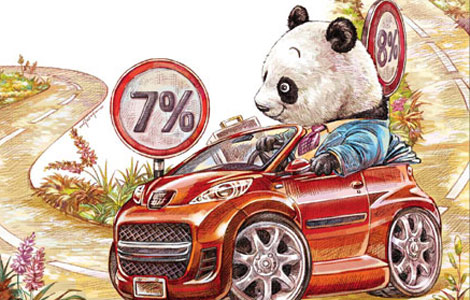GM foods make its way to China market
Updated: 2013-09-29 09:59
(bjreview.com.cn)
|
||||||||
Data from the International Service for the Acquisition of Agri-biotech Applications (ISAAA) showed that 81 percent of the world's soybeans, 81 percent of its cotton, 35 percent of corn and 30 percent of oilseed rape was genetically modified in 2012, and most of those products have been sold to China.
The popularity of GM foods in China may be growing, but so too is the debate on whether it is safe to consume. Many Chinese resist GM foods simply because they fear it may cause cancer. "The government has allowed the import of GM soybeans, so it owes us a convincing explanation on whether or not it's safe," said Wang, the Beijing native.
The Ministry of Agriculture (MOA) says concerns over GM foods are unnecessary. China's GM foods must comply with three principles: First, the food must be traced back to its origins; second, the food should have a label saying it's genetically modified; third, the food should be controlled within certain regions so that all residents have the right to know and to choose. The MOA has also called on experts to promote GM foods throughout China. So far, the MOA has approved the import of GM cotton, soybeans, corn and oilseed rape.
An attitude change
As long as no attempts are made to change the population's attitude toward GM foods, skepticism will continue.
Research on GM grains in China goes back to Yuan Longping, father of hybrid rice. Chinese people have generally accepted hybrid rice but not GM soybeans, mainly because of a lack of promotion and popularization.
"The fact is, people are surrounded by GM foods, even if they are unaware of it," said Deng Zhixi, deputy director of the Research Center for Rural Economy under the MOA. "No matter if it is in China or the United States, you can't survive without eating GM foods. There are less and less non-GM foods now. We should take a more rational approach toward it." Deng said the United States had led the world in the GM breeding technology. If China is mired in endless disputes instead of following the lead of the United States, food security could once again rear its ugly head in the future.
Huang Dafang, director of the Biotechnology Research Institute under the CAAS, said GM technology has yielded great social, economic and biological benefits during its 17 years of development. According to a report from the ISAAA, 28 countries planted GM crops in 2012.
There are three types of GM products. The first are products that are able to survive environmental challenges, such as insect-resistant, disease-resistant and frost-resistant products. Most GM products belong to this category. The second type enhances quality and nutrition. This group includes GM soybeans. The third type is for medical use, such as vaccines and medicine.
But everyday Chinese are unaware of the variations and uses of GM products, experts lament. "Changing people's attitude toward GM foods is a long process," says Huang. "The most urgent need is to clear their doubts and fear."
Earlier reports
List of approved GM food clarified
Will you buy genetically modified (GM) food?

 Home schooling popular with Chinese parents
Home schooling popular with Chinese parents
 Royal Mint coins to mark Prince George christening
Royal Mint coins to mark Prince George christening
 29th Golden Rooster Awards
29th Golden Rooster Awards
 China marks birthday anniversary of Confucius
China marks birthday anniversary of Confucius
 Obama, Iran's Rouhani hold historic phone call
Obama, Iran's Rouhani hold historic phone call
 Li Na learns from her past
Li Na learns from her past
 Picture brightens for corporate profits
Picture brightens for corporate profits
 Afghanistan seeks active Beijing role
Afghanistan seeks active Beijing role
Most Viewed
Editor's Picks

|

|

|

|

|

|
Today's Top News
China on yellow alert as Typhoon Wutip nears
East China cities debut 4G phones
Deaths in Mumbai building collapse climb to 43
Mass rabies vaccinations called for
12 trapped in N China coal mine accident
Royal Mint coins to mark Prince George christening
Anti-graft teams report violations to authority
UN's Syria resolution on point, FM says
US Weekly

|

|







